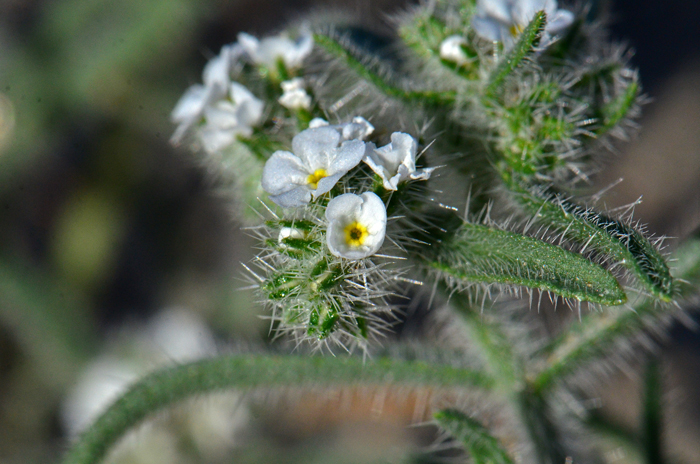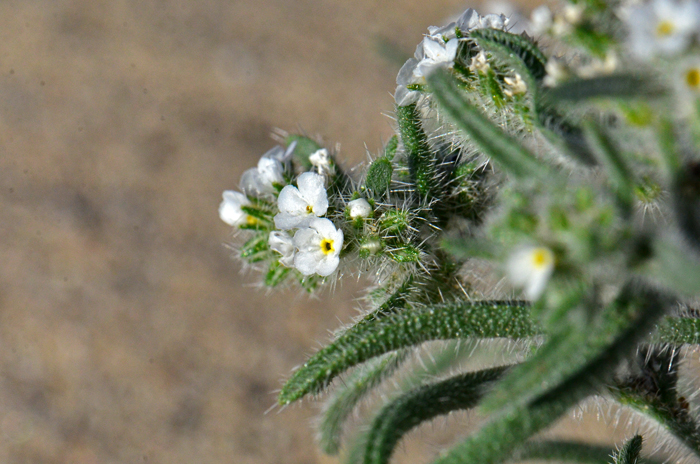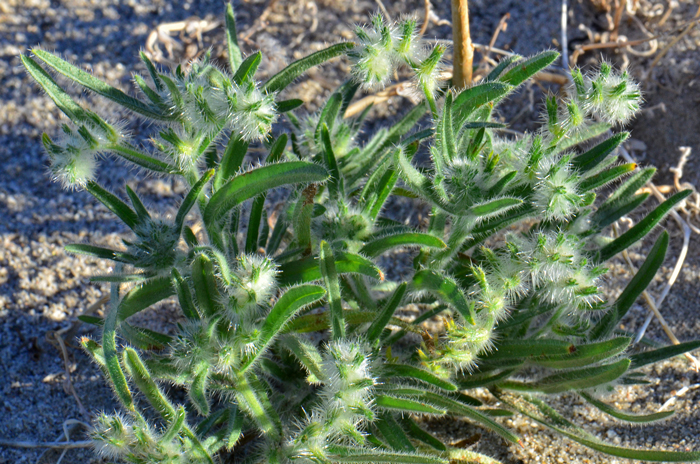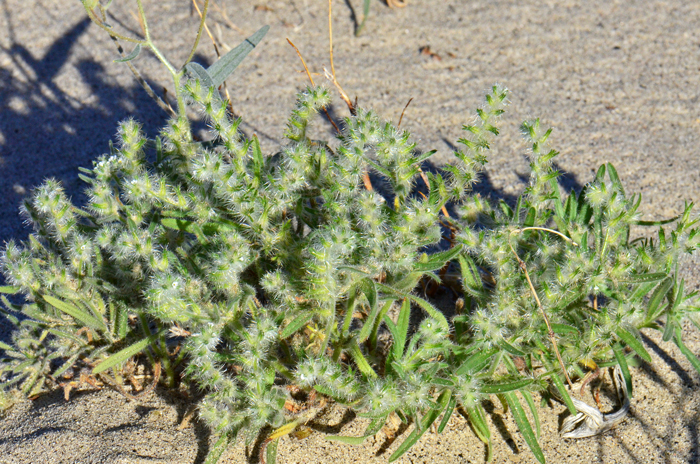Cryptantha ganderi, Gander's Cryptantha




Scientific Name: Cryptantha ganderi
Common Name: Gander's Cryptantha
Also Called: Dune Cat's-Eye
Family: Boraginaceae, Forget-Me-Not Family
Synonyms: ()
Status: Native
Duration: Annual
Size: Up to 15 inches more or less (40 cm)
Growth Form: Forb/herb; Plants stout, stems single or branching generally throughout, hairs straight and stiff, (strigose) and rough-hairy to bristly; hairs extending horizontally (spreading).
Leaves: Green; leaves not divided into leaflets (simple), with a smooth margins (entire); linear to narrowly-lanceolate; straight stiff hair (bristles) that are extending horizontally (spreading), some of the hairs are bulbous at the base; the base leaves are whorled, the stem leaves (cauline) are usually opposite below and alternate above.
Flower Color: White, flowers in 1's, occasionally clustered; flowering stem (inflorescence) a terminal (cyme); corolla mostly white with 5 minute secondary parts attached to the main structure (appendages) pale yellow in the center; sepals free; fruit a nutlet.
Flowering Season: January or February to May
Elevation: 500 to 1,200 feet (150-370 m).
Habitat Preferences: Deserts, sand dune, sandy open areas, silty fine sand, creosote bush communities and Sonoran desert scrub.
Recorded Range: Cryptantha ganderi is rare in the United States; it is found only in AZ and CA. In CA it is found in the Borrego Valley area and in AZ it is found in the Yuma area. It is also native to Baja California, Sonora and northwest Mexico.
North America & US County Distribution Map for Cryptantha ganderi.
U.S. Weed Information: No information available.
Invasive/Noxious Weed Information: No information available.
Wetland Indicator: No information available.
Threatened/Endangered Information: In North America Cryptantha ganderi is listed as Rare Plant Rank: 1B.1; Rare, threatened, or endangered in California and elsewhere; 1: Seriously endangered in California. This species is known in CA from approximately five occurrences. Seriously threatened by development and vehicles.
In the Southwestern United States: Arizona has 37 species of genus, California has 60 species, Nevada has 44 species, New Mexico has 23 species, Texas has 15 species, Utah has 55 species. All data approximate and subject to revision.
The genus Cryptantha was published by Johann Georg Christian Lehmann in 1837.
Comments: Gander's Cryptantha is a small bristly species of Cryptantha that is listed as rare, either threatened or endangered in California. In Arizona it is limited in distribution to the dry sandy areas of the southwest corner of the state (Yuma County).
Members of the genus Cryptantha are collectively referred to as Cat’s Eyes or Popcorn Flowers.
Cryptantha species have typically white flowers in spikes like a scorpions (scorpioid) tail. They are often difficult to identify in the field or lab and a close examination (10x loupe or dissecting scope) of the flowers and the small seeds or nutlets is usually required.
Gander's Cryptantha is named in honor of Frank Forest Gander (1899-1976); American botanist and zoologist in San Diego, California.
In Southwest Desert Flora also see: Bearded Cryptantha, Cryptantha barbigera, Narrowstem Cryptantha, Cryptantha gracilis, Panamint Cryptantha, Johnsonella angustifolia (Cryptantha), Redroot Cryptantha, Cryptantha micrantha, Torrey's Cryptantha, Cryptantha torreyana, and Wingnut Cryptantha, Cryptantha pterocarya.
The species epithet "ganderi" (gan'deri:) is named in honor of Frank Forest Gander (1899-1976), botanist and zoologist in San Diego, California.

